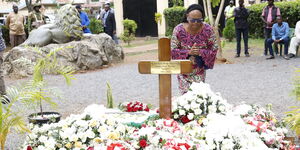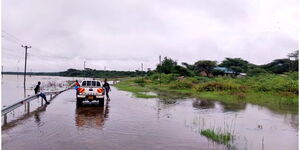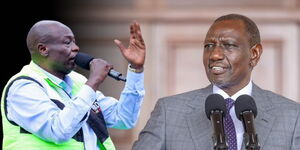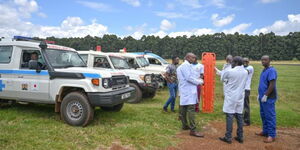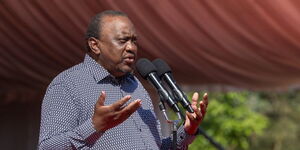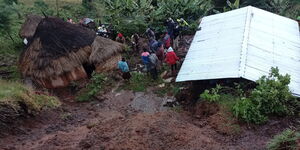The Kenya Defence Forces (KDF) is the security organ charged with defending the nation’s borders, whether by land, sea, or air.
Often referred to as the ‘disciplined forces’, the KDF is known for its structure and organisation, which stems from well-defined military ranks.
Military ranks, aside from providing structure within the KDF, also establish a system of leadership in the Kenyan military and indicate a soldier’s level of expertise and authority.
You might have heard of the titles General, Major General, Colonel, Lieutenant General, and even Commander. These ranks all exist within a hierarchy and play a significant role in the KDF’s operations and activities.
Whether in the Kenya Army, which secures the country on land, the Kenya Navy, which defends the nation’s seas, or the Kenya Air Force, which deals with Kenya’s airspace, these ranks are present, creating an efficient leadership ecosystem within the KDF.
A key thing to note is that KDF ranks have adopted a distinct two-tier system of Officers and Service Members. Officers are at the top of the hierarchy and are granted commission by the Commander-in-Chief, thus referred to as commissioned officers. The officers’ ranks are displayed on the shoulder.
Commissioned Officers
So, what is the highest rank in the military? This would be the rank of ‘General’, a four-star military officer who also doubles up as the Chief of Defence. As the highest-ranking military officer, the General heads the KDF and holds an executive role in the leadership, strategy and command of the KDF.
Notably, only one officer holds this position in the KDF, emphasising the seniority and power attached to the role. However, the General, or CDF, still ranks below the President, who is the overall Commander-in-Chief of the Defence Forces, and the only five-star General.
Even so, the General is the principal military advisor to the President and the National Security Council, providing strategic military advice on all matters of national security. The current General is Charles Kahariri, who ascended to the role after the tragic passing of General Ogolla.
Directly below the General is the Lieutenant General, who often holds positions such as the Vice Chief of Defence Forces (VCDF) or Service Commander (Commander Kenya Army, Commander Kenya Air Force, Commander Kenya Navy).
Below the Lieutenant General is a Major General, who typically commands a division, which consists of multiple brigades (around 6,000 to 15,000 soldiers). Some of them are appointed as service commanders, such as in the case of the Kenya Navy and the Kenya Air Force.
Next is the Brigadier, who commands a brigade, comprising several thousand soldiers. In the past, the rank was also known as the Brigadier General, the lowest-ranking ‘General’ officer. After the Brigadier is the Colonel, who serves as a staff officer or a senior operational advisor to higher-ranking officers. Typically, a Colonel does not command troops directly in the field.
Following the Colonel is Lieutenant Colonel, often known as a commanding officer. The LtC commands units of approximately 600-650 soldiers, i.e. a battalion. Below the LC is a Major, in charge of a sub-unit of up to 120 officers (e.g., a company). This officer is responsible for managing equipment, training, and operations at this level.
After the Major is a Captain, who commands a company of 50 to 150 soldiers or serves as a second-in-command. The Captain is followed by a Lieutenant (Lt) who leads a platoon or troop, usually between 25 to 30 soldiers.
The lowest-ranked commissioned officer in the KDF is a Second Lieutenant (2Lt), and this officer commands a platoon with limited responsibilities. This rank is attained upon commissioning from the Kenya Military Academy.
Non-Commissioned Officers
Non-Commissioned Officers (NCOs) are widely considered the backbone of the military, responsible for leading, training, and disciplining soldiers at the ground level. Their positions are earned through promotion from the enlisted ranks.
There are six ranks within the NCO cadre, with the Warrant Officer Class I (WOI) being the senior-most rank. They often serve as Regimental Sergeant Majors or provide senior advice to commanding officers.
Next is the Warrant Officer Class II (WOII), senior NCOs who focus on training and discipline within a company or sub-unit. WOII is followed by the Senior Sergeant, who holds significant responsibility, often commanding companies or advising junior officers.
Below that rank is the Sergeant, who is second-in-command of a platoon. Next is the Corporal, who leads a small team of soldiers. The Lance Corporal is a junior non-commissioned officer, typically leading a fire team.
The extensive military ranks end with the rank of Private, attained after completing basic military training.
Progression in the military is tied to several factors, such as Time in Service (total amount of time spent in the military), Time in Grade (total amount of time spent in rank) , performance evaluations, education and training (Professional Military Education-PME), leadership potential, physical fitness and discipline.
Other factors such as board selections and processes, particularly for high-ranking officers, deployment and operational experience, branch and military occupational speciality (MOS) needs.
For the CDF, a specialised set of unofficial rules, known as the “Tonje Rules”, guides the succession system for the military boss.
They stipulate a four-year term limit for the CDF and mandate rotation of the position among the Kenya Army, Air Force, and Navy. These rules, introduced by General Daudi Tonje, aim to ensure professionalism, predictability, and stability in KDF leadership transitions, fostering institutionalism over individual power.


